Organisation and Behaviour Report: Motivation, Teams, and BA Analysis
VerifiedAdded on 2020/09/17
|13
|3645
|113
Report
AI Summary
This report delves into the realm of organizational behavior, focusing on motivation theories and team dynamics within the context of British Airways. It begins by evaluating various motivation theories, including extrinsic and intrinsic motivation, content theories like Maslow's hierarchy of needs and McGregor's Theory X and Y, and process theories such as Vroom's expectancy theory, assessing their relevance to the airline's operations. The report then examines factors that contribute to effective teams, contrasting them with ineffective teams, and explores team development theories like Tuckman's stages of group development. Furthermore, it discusses the interplay between organizational culture, power dynamics, motivation, and workplace politics, providing a holistic view of how these elements shape employee behavior and performance within the organization. The analysis provides insights into the practical application of these concepts within a real-world business setting.
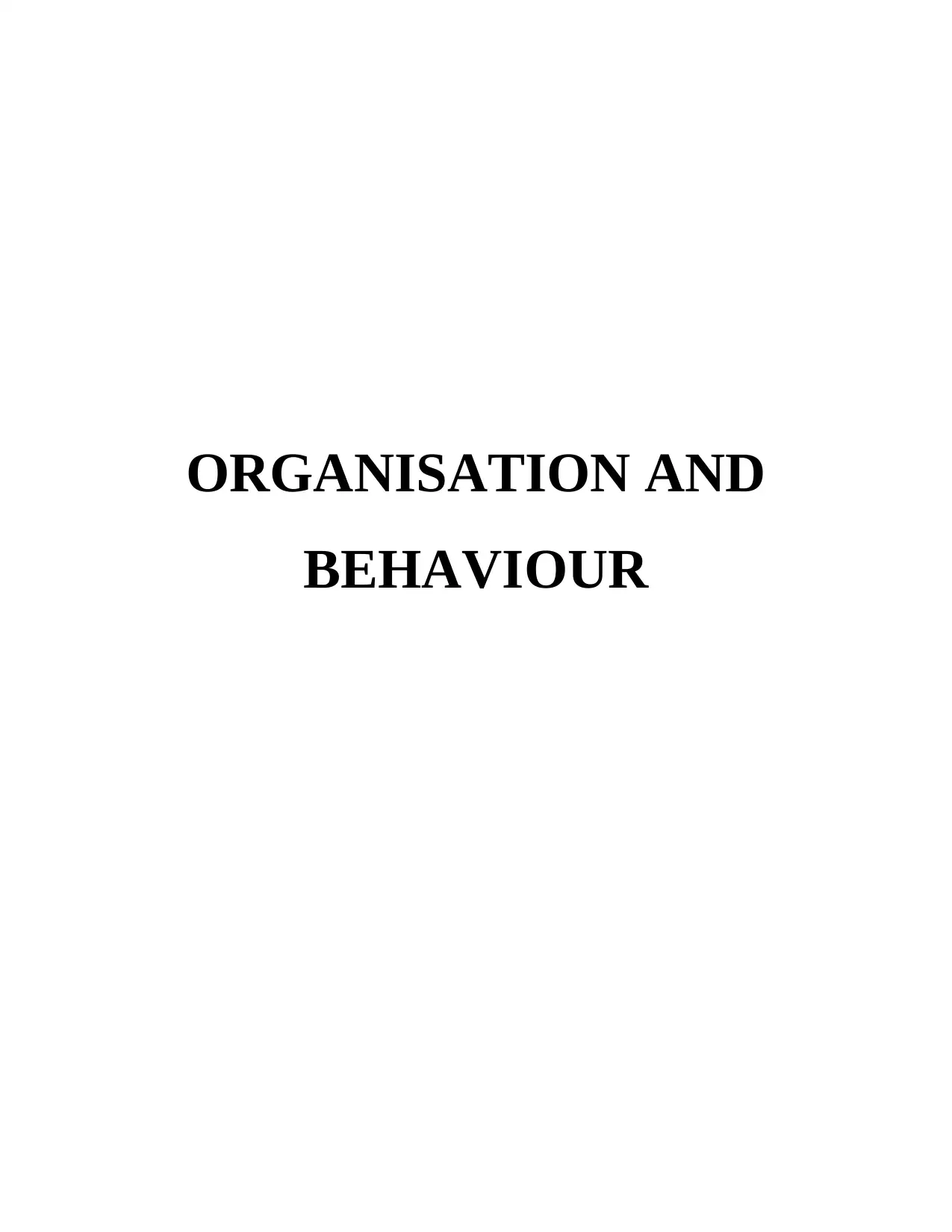
ORGANISATION AND
BEHAVIOUR
BEHAVIOUR
Paraphrase This Document
Need a fresh take? Get an instant paraphrase of this document with our AI Paraphraser
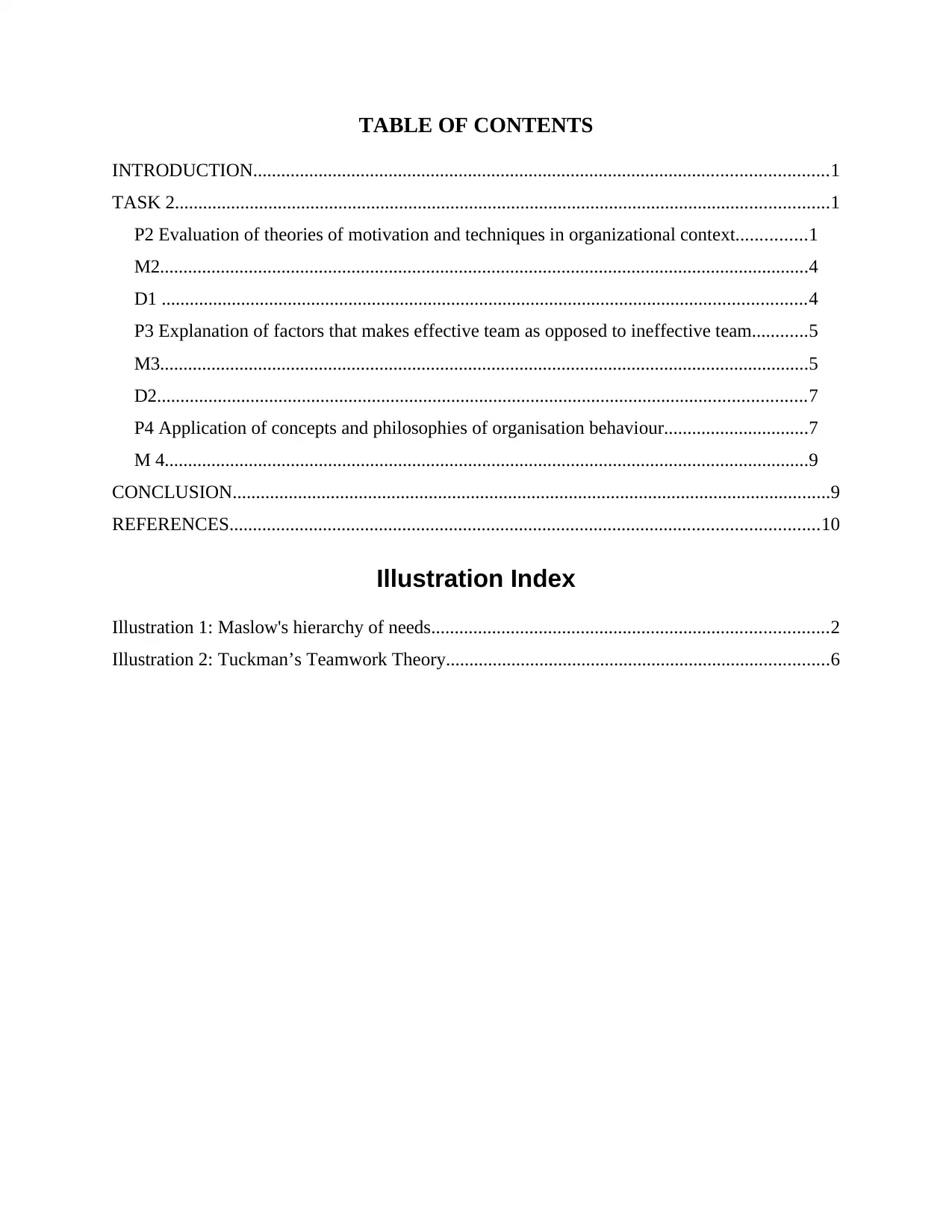
TABLE OF CONTENTS
INTRODUCTION...........................................................................................................................1
TASK 2............................................................................................................................................1
P2 Evaluation of theories of motivation and techniques in organizational context...............1
M2...........................................................................................................................................4
D1 ..........................................................................................................................................4
P3 Explanation of factors that makes effective team as opposed to ineffective team............5
M3...........................................................................................................................................5
D2...........................................................................................................................................7
P4 Application of concepts and philosophies of organisation behaviour...............................7
M 4..........................................................................................................................................9
CONCLUSION................................................................................................................................9
REFERENCES..............................................................................................................................10
Illustration Index
Illustration 1: Maslow's hierarchy of needs.....................................................................................2
Illustration 2: Tuckman’s Teamwork Theory..................................................................................6
INTRODUCTION...........................................................................................................................1
TASK 2............................................................................................................................................1
P2 Evaluation of theories of motivation and techniques in organizational context...............1
M2...........................................................................................................................................4
D1 ..........................................................................................................................................4
P3 Explanation of factors that makes effective team as opposed to ineffective team............5
M3...........................................................................................................................................5
D2...........................................................................................................................................7
P4 Application of concepts and philosophies of organisation behaviour...............................7
M 4..........................................................................................................................................9
CONCLUSION................................................................................................................................9
REFERENCES..............................................................................................................................10
Illustration Index
Illustration 1: Maslow's hierarchy of needs.....................................................................................2
Illustration 2: Tuckman’s Teamwork Theory..................................................................................6
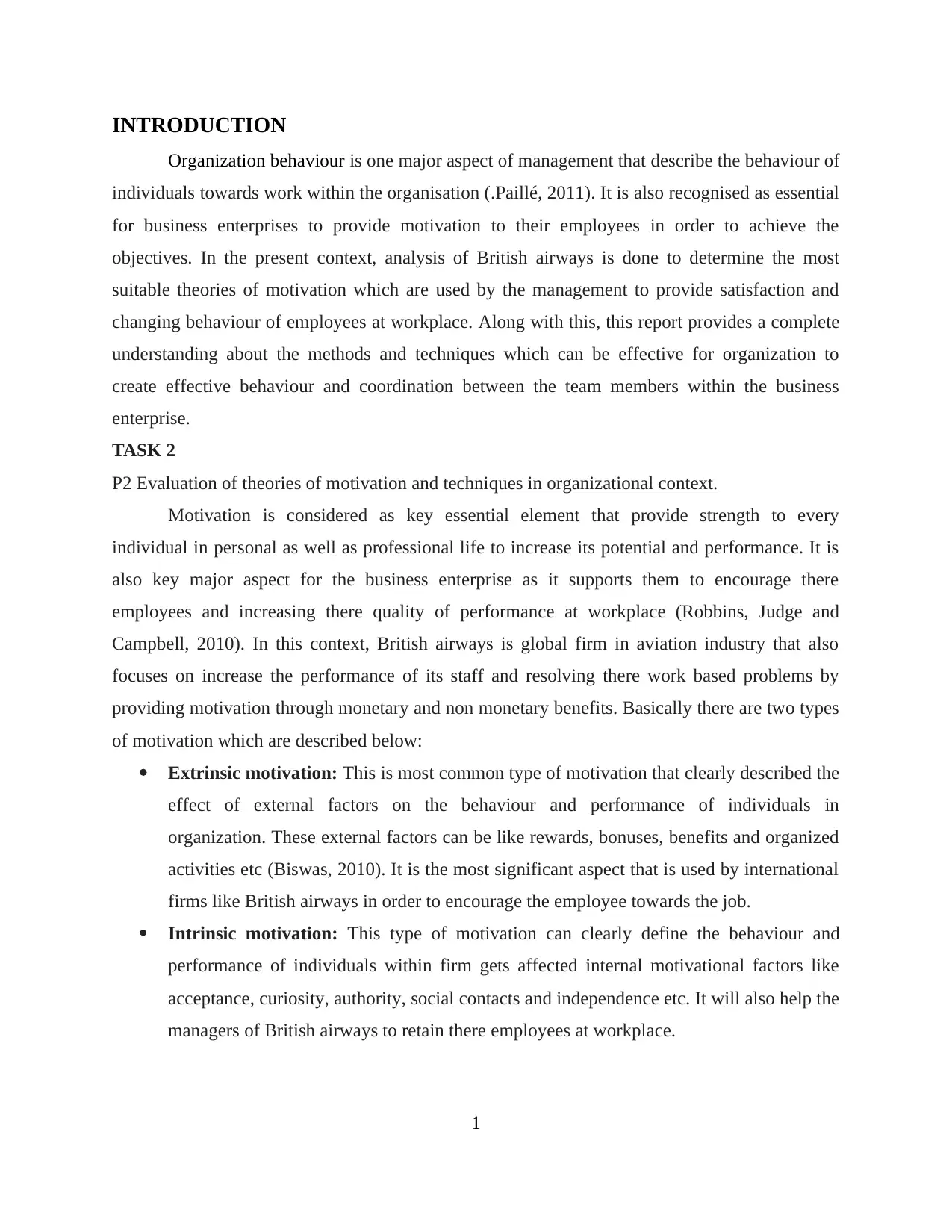
INTRODUCTION
Organization behaviour is one major aspect of management that describe the behaviour of
individuals towards work within the organisation (.Paillé, 2011). It is also recognised as essential
for business enterprises to provide motivation to their employees in order to achieve the
objectives. In the present context, analysis of British airways is done to determine the most
suitable theories of motivation which are used by the management to provide satisfaction and
changing behaviour of employees at workplace. Along with this, this report provides a complete
understanding about the methods and techniques which can be effective for organization to
create effective behaviour and coordination between the team members within the business
enterprise.
TASK 2
P2 Evaluation of theories of motivation and techniques in organizational context.
Motivation is considered as key essential element that provide strength to every
individual in personal as well as professional life to increase its potential and performance. It is
also key major aspect for the business enterprise as it supports them to encourage there
employees and increasing there quality of performance at workplace (Robbins, Judge and
Campbell, 2010). In this context, British airways is global firm in aviation industry that also
focuses on increase the performance of its staff and resolving there work based problems by
providing motivation through monetary and non monetary benefits. Basically there are two types
of motivation which are described below:
Extrinsic motivation: This is most common type of motivation that clearly described the
effect of external factors on the behaviour and performance of individuals in
organization. These external factors can be like rewards, bonuses, benefits and organized
activities etc (Biswas, 2010). It is the most significant aspect that is used by international
firms like British airways in order to encourage the employee towards the job.
Intrinsic motivation: This type of motivation can clearly define the behaviour and
performance of individuals within firm gets affected internal motivational factors like
acceptance, curiosity, authority, social contacts and independence etc. It will also help the
managers of British airways to retain there employees at workplace.
1
Organization behaviour is one major aspect of management that describe the behaviour of
individuals towards work within the organisation (.Paillé, 2011). It is also recognised as essential
for business enterprises to provide motivation to their employees in order to achieve the
objectives. In the present context, analysis of British airways is done to determine the most
suitable theories of motivation which are used by the management to provide satisfaction and
changing behaviour of employees at workplace. Along with this, this report provides a complete
understanding about the methods and techniques which can be effective for organization to
create effective behaviour and coordination between the team members within the business
enterprise.
TASK 2
P2 Evaluation of theories of motivation and techniques in organizational context.
Motivation is considered as key essential element that provide strength to every
individual in personal as well as professional life to increase its potential and performance. It is
also key major aspect for the business enterprise as it supports them to encourage there
employees and increasing there quality of performance at workplace (Robbins, Judge and
Campbell, 2010). In this context, British airways is global firm in aviation industry that also
focuses on increase the performance of its staff and resolving there work based problems by
providing motivation through monetary and non monetary benefits. Basically there are two types
of motivation which are described below:
Extrinsic motivation: This is most common type of motivation that clearly described the
effect of external factors on the behaviour and performance of individuals in
organization. These external factors can be like rewards, bonuses, benefits and organized
activities etc (Biswas, 2010). It is the most significant aspect that is used by international
firms like British airways in order to encourage the employee towards the job.
Intrinsic motivation: This type of motivation can clearly define the behaviour and
performance of individuals within firm gets affected internal motivational factors like
acceptance, curiosity, authority, social contacts and independence etc. It will also help the
managers of British airways to retain there employees at workplace.
1
⊘ This is a preview!⊘
Do you want full access?
Subscribe today to unlock all pages.

Trusted by 1+ million students worldwide
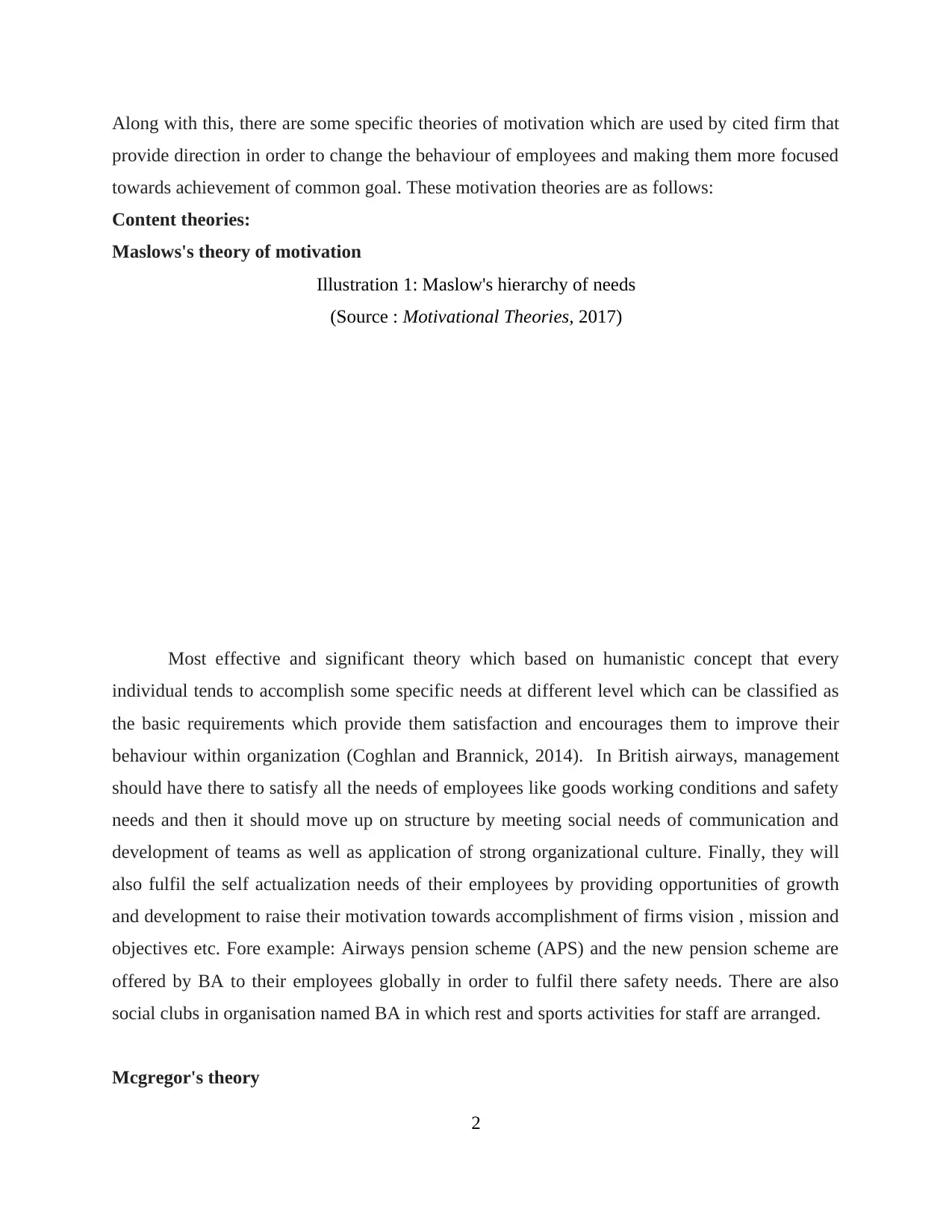
Along with this, there are some specific theories of motivation which are used by cited firm that
provide direction in order to change the behaviour of employees and making them more focused
towards achievement of common goal. These motivation theories are as follows:
Content theories:
Maslows's theory of motivation
Most effective and significant theory which based on humanistic concept that every
individual tends to accomplish some specific needs at different level which can be classified as
the basic requirements which provide them satisfaction and encourages them to improve their
behaviour within organization (Coghlan and Brannick, 2014). In British airways, management
should have there to satisfy all the needs of employees like goods working conditions and safety
needs and then it should move up on structure by meeting social needs of communication and
development of teams as well as application of strong organizational culture. Finally, they will
also fulfil the self actualization needs of their employees by providing opportunities of growth
and development to raise their motivation towards accomplishment of firms vision , mission and
objectives etc. Fore example: Airways pension scheme (APS) and the new pension scheme are
offered by BA to their employees globally in order to fulfil there safety needs. There are also
social clubs in organisation named BA in which rest and sports activities for staff are arranged.
Mcgregor's theory
2
Illustration 1: Maslow's hierarchy of needs
(Source : Motivational Theories, 2017)
provide direction in order to change the behaviour of employees and making them more focused
towards achievement of common goal. These motivation theories are as follows:
Content theories:
Maslows's theory of motivation
Most effective and significant theory which based on humanistic concept that every
individual tends to accomplish some specific needs at different level which can be classified as
the basic requirements which provide them satisfaction and encourages them to improve their
behaviour within organization (Coghlan and Brannick, 2014). In British airways, management
should have there to satisfy all the needs of employees like goods working conditions and safety
needs and then it should move up on structure by meeting social needs of communication and
development of teams as well as application of strong organizational culture. Finally, they will
also fulfil the self actualization needs of their employees by providing opportunities of growth
and development to raise their motivation towards accomplishment of firms vision , mission and
objectives etc. Fore example: Airways pension scheme (APS) and the new pension scheme are
offered by BA to their employees globally in order to fulfil there safety needs. There are also
social clubs in organisation named BA in which rest and sports activities for staff are arranged.
Mcgregor's theory
2
Illustration 1: Maslow's hierarchy of needs
(Source : Motivational Theories, 2017)
Paraphrase This Document
Need a fresh take? Get an instant paraphrase of this document with our AI Paraphraser
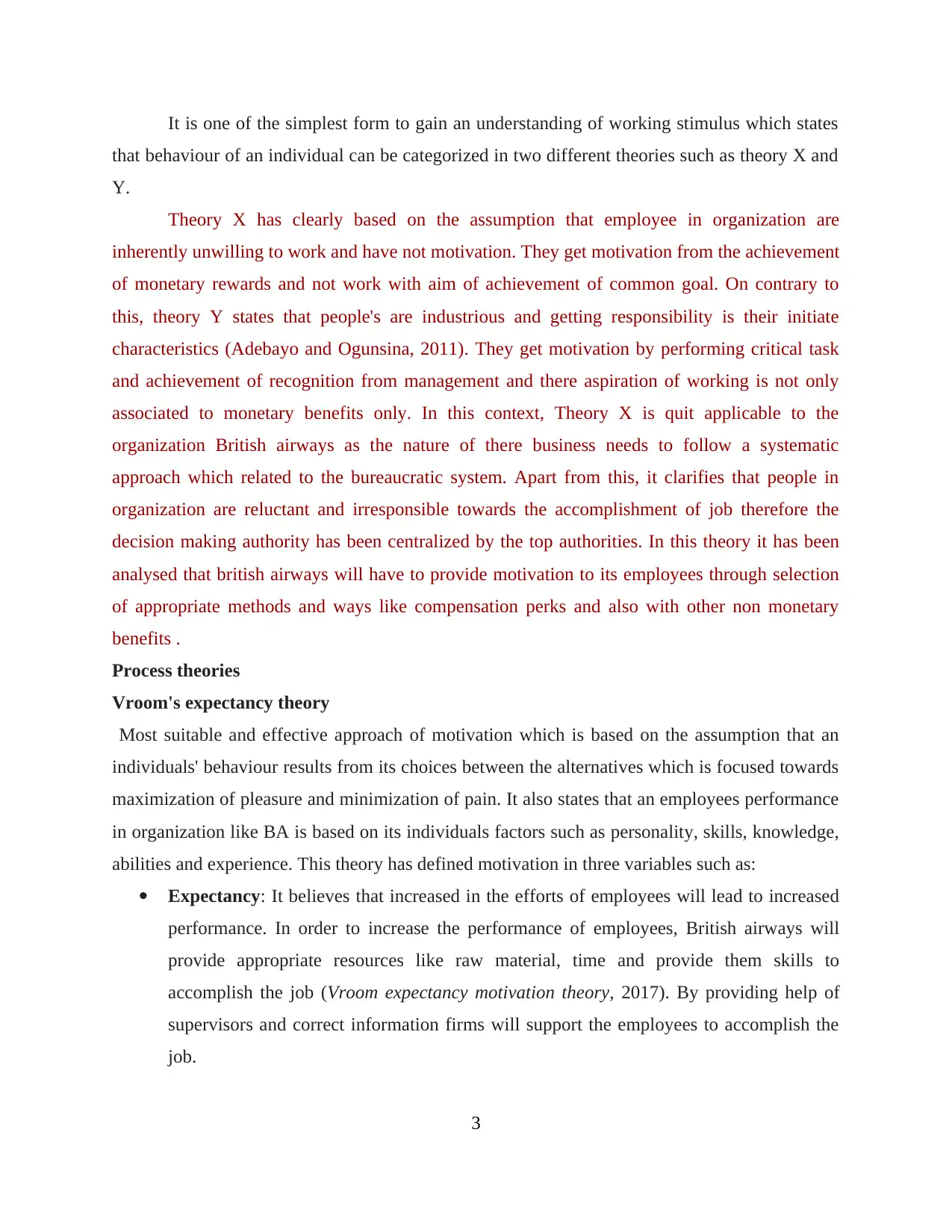
It is one of the simplest form to gain an understanding of working stimulus which states
that behaviour of an individual can be categorized in two different theories such as theory X and
Y.
Theory X has clearly based on the assumption that employee in organization are
inherently unwilling to work and have not motivation. They get motivation from the achievement
of monetary rewards and not work with aim of achievement of common goal. On contrary to
this, theory Y states that people's are industrious and getting responsibility is their initiate
characteristics (Adebayo and Ogunsina, 2011). They get motivation by performing critical task
and achievement of recognition from management and there aspiration of working is not only
associated to monetary benefits only. In this context, Theory X is quit applicable to the
organization British airways as the nature of there business needs to follow a systematic
approach which related to the bureaucratic system. Apart from this, it clarifies that people in
organization are reluctant and irresponsible towards the accomplishment of job therefore the
decision making authority has been centralized by the top authorities. In this theory it has been
analysed that british airways will have to provide motivation to its employees through selection
of appropriate methods and ways like compensation perks and also with other non monetary
benefits .
Process theories
Vroom's expectancy theory
Most suitable and effective approach of motivation which is based on the assumption that an
individuals' behaviour results from its choices between the alternatives which is focused towards
maximization of pleasure and minimization of pain. It also states that an employees performance
in organization like BA is based on its individuals factors such as personality, skills, knowledge,
abilities and experience. This theory has defined motivation in three variables such as:
Expectancy: It believes that increased in the efforts of employees will lead to increased
performance. In order to increase the performance of employees, British airways will
provide appropriate resources like raw material, time and provide them skills to
accomplish the job (Vroom expectancy motivation theory, 2017). By providing help of
supervisors and correct information firms will support the employees to accomplish the
job.
3
that behaviour of an individual can be categorized in two different theories such as theory X and
Y.
Theory X has clearly based on the assumption that employee in organization are
inherently unwilling to work and have not motivation. They get motivation from the achievement
of monetary rewards and not work with aim of achievement of common goal. On contrary to
this, theory Y states that people's are industrious and getting responsibility is their initiate
characteristics (Adebayo and Ogunsina, 2011). They get motivation by performing critical task
and achievement of recognition from management and there aspiration of working is not only
associated to monetary benefits only. In this context, Theory X is quit applicable to the
organization British airways as the nature of there business needs to follow a systematic
approach which related to the bureaucratic system. Apart from this, it clarifies that people in
organization are reluctant and irresponsible towards the accomplishment of job therefore the
decision making authority has been centralized by the top authorities. In this theory it has been
analysed that british airways will have to provide motivation to its employees through selection
of appropriate methods and ways like compensation perks and also with other non monetary
benefits .
Process theories
Vroom's expectancy theory
Most suitable and effective approach of motivation which is based on the assumption that an
individuals' behaviour results from its choices between the alternatives which is focused towards
maximization of pleasure and minimization of pain. It also states that an employees performance
in organization like BA is based on its individuals factors such as personality, skills, knowledge,
abilities and experience. This theory has defined motivation in three variables such as:
Expectancy: It believes that increased in the efforts of employees will lead to increased
performance. In order to increase the performance of employees, British airways will
provide appropriate resources like raw material, time and provide them skills to
accomplish the job (Vroom expectancy motivation theory, 2017). By providing help of
supervisors and correct information firms will support the employees to accomplish the
job.
3
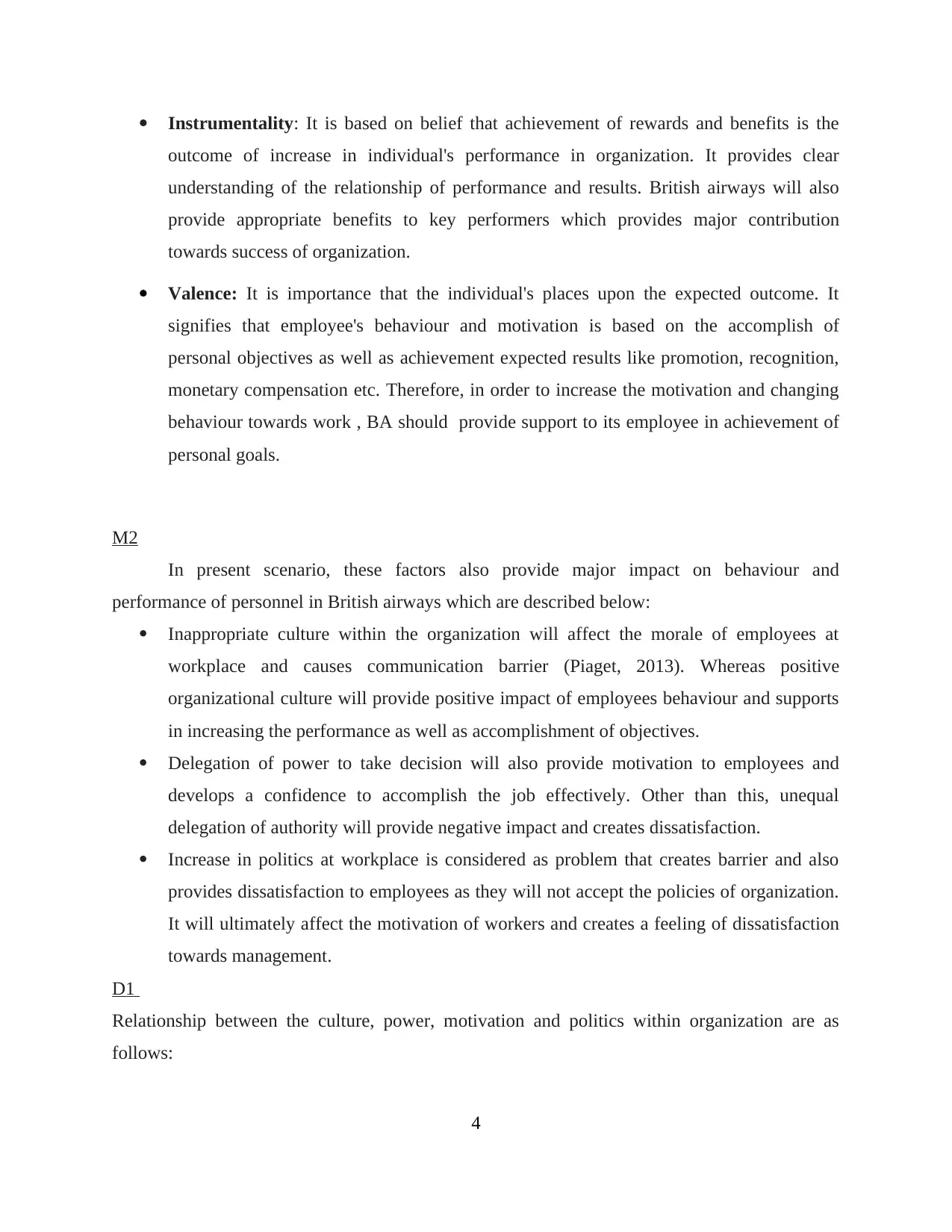
Instrumentality: It is based on belief that achievement of rewards and benefits is the
outcome of increase in individual's performance in organization. It provides clear
understanding of the relationship of performance and results. British airways will also
provide appropriate benefits to key performers which provides major contribution
towards success of organization.
Valence: It is importance that the individual's places upon the expected outcome. It
signifies that employee's behaviour and motivation is based on the accomplish of
personal objectives as well as achievement expected results like promotion, recognition,
monetary compensation etc. Therefore, in order to increase the motivation and changing
behaviour towards work , BA should provide support to its employee in achievement of
personal goals.
M2
In present scenario, these factors also provide major impact on behaviour and
performance of personnel in British airways which are described below:
Inappropriate culture within the organization will affect the morale of employees at
workplace and causes communication barrier (Piaget, 2013). Whereas positive
organizational culture will provide positive impact of employees behaviour and supports
in increasing the performance as well as accomplishment of objectives.
Delegation of power to take decision will also provide motivation to employees and
develops a confidence to accomplish the job effectively. Other than this, unequal
delegation of authority will provide negative impact and creates dissatisfaction.
Increase in politics at workplace is considered as problem that creates barrier and also
provides dissatisfaction to employees as they will not accept the policies of organization.
It will ultimately affect the motivation of workers and creates a feeling of dissatisfaction
towards management.
D1
Relationship between the culture, power, motivation and politics within organization are as
follows:
4
outcome of increase in individual's performance in organization. It provides clear
understanding of the relationship of performance and results. British airways will also
provide appropriate benefits to key performers which provides major contribution
towards success of organization.
Valence: It is importance that the individual's places upon the expected outcome. It
signifies that employee's behaviour and motivation is based on the accomplish of
personal objectives as well as achievement expected results like promotion, recognition,
monetary compensation etc. Therefore, in order to increase the motivation and changing
behaviour towards work , BA should provide support to its employee in achievement of
personal goals.
M2
In present scenario, these factors also provide major impact on behaviour and
performance of personnel in British airways which are described below:
Inappropriate culture within the organization will affect the morale of employees at
workplace and causes communication barrier (Piaget, 2013). Whereas positive
organizational culture will provide positive impact of employees behaviour and supports
in increasing the performance as well as accomplishment of objectives.
Delegation of power to take decision will also provide motivation to employees and
develops a confidence to accomplish the job effectively. Other than this, unequal
delegation of authority will provide negative impact and creates dissatisfaction.
Increase in politics at workplace is considered as problem that creates barrier and also
provides dissatisfaction to employees as they will not accept the policies of organization.
It will ultimately affect the motivation of workers and creates a feeling of dissatisfaction
towards management.
D1
Relationship between the culture, power, motivation and politics within organization are as
follows:
4
⊘ This is a preview!⊘
Do you want full access?
Subscribe today to unlock all pages.

Trusted by 1+ million students worldwide
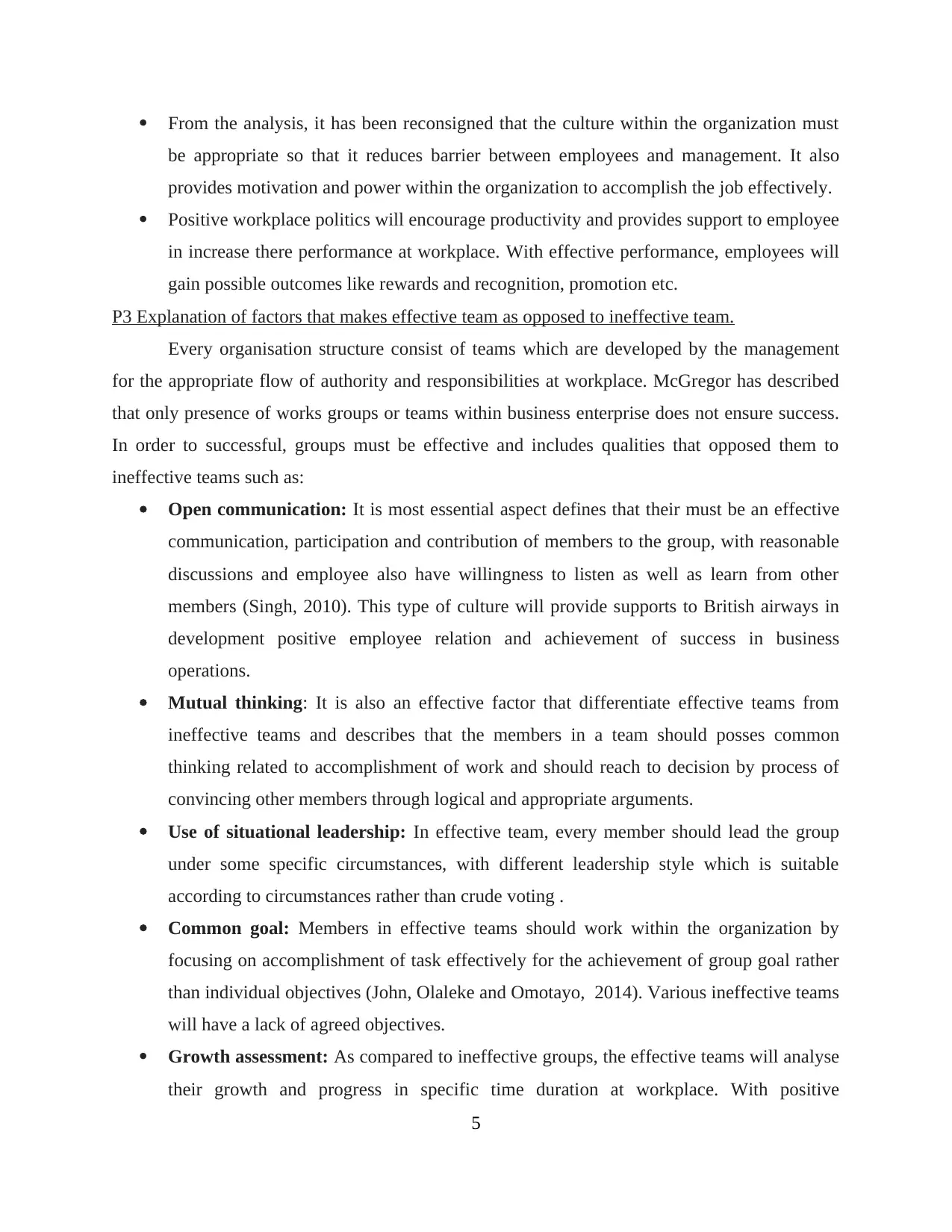
From the analysis, it has been reconsigned that the culture within the organization must
be appropriate so that it reduces barrier between employees and management. It also
provides motivation and power within the organization to accomplish the job effectively.
Positive workplace politics will encourage productivity and provides support to employee
in increase there performance at workplace. With effective performance, employees will
gain possible outcomes like rewards and recognition, promotion etc.
P3 Explanation of factors that makes effective team as opposed to ineffective team.
Every organisation structure consist of teams which are developed by the management
for the appropriate flow of authority and responsibilities at workplace. McGregor has described
that only presence of works groups or teams within business enterprise does not ensure success.
In order to successful, groups must be effective and includes qualities that opposed them to
ineffective teams such as:
Open communication: It is most essential aspect defines that their must be an effective
communication, participation and contribution of members to the group, with reasonable
discussions and employee also have willingness to listen as well as learn from other
members (Singh, 2010). This type of culture will provide supports to British airways in
development positive employee relation and achievement of success in business
operations.
Mutual thinking: It is also an effective factor that differentiate effective teams from
ineffective teams and describes that the members in a team should posses common
thinking related to accomplishment of work and should reach to decision by process of
convincing other members through logical and appropriate arguments.
Use of situational leadership: In effective team, every member should lead the group
under some specific circumstances, with different leadership style which is suitable
according to circumstances rather than crude voting .
Common goal: Members in effective teams should work within the organization by
focusing on accomplishment of task effectively for the achievement of group goal rather
than individual objectives (John, Olaleke and Omotayo, 2014). Various ineffective teams
will have a lack of agreed objectives.
Growth assessment: As compared to ineffective groups, the effective teams will analyse
their growth and progress in specific time duration at workplace. With positive
5
be appropriate so that it reduces barrier between employees and management. It also
provides motivation and power within the organization to accomplish the job effectively.
Positive workplace politics will encourage productivity and provides support to employee
in increase there performance at workplace. With effective performance, employees will
gain possible outcomes like rewards and recognition, promotion etc.
P3 Explanation of factors that makes effective team as opposed to ineffective team.
Every organisation structure consist of teams which are developed by the management
for the appropriate flow of authority and responsibilities at workplace. McGregor has described
that only presence of works groups or teams within business enterprise does not ensure success.
In order to successful, groups must be effective and includes qualities that opposed them to
ineffective teams such as:
Open communication: It is most essential aspect defines that their must be an effective
communication, participation and contribution of members to the group, with reasonable
discussions and employee also have willingness to listen as well as learn from other
members (Singh, 2010). This type of culture will provide supports to British airways in
development positive employee relation and achievement of success in business
operations.
Mutual thinking: It is also an effective factor that differentiate effective teams from
ineffective teams and describes that the members in a team should posses common
thinking related to accomplishment of work and should reach to decision by process of
convincing other members through logical and appropriate arguments.
Use of situational leadership: In effective team, every member should lead the group
under some specific circumstances, with different leadership style which is suitable
according to circumstances rather than crude voting .
Common goal: Members in effective teams should work within the organization by
focusing on accomplishment of task effectively for the achievement of group goal rather
than individual objectives (John, Olaleke and Omotayo, 2014). Various ineffective teams
will have a lack of agreed objectives.
Growth assessment: As compared to ineffective groups, the effective teams will analyse
their growth and progress in specific time duration at workplace. With positive
5
Paraphrase This Document
Need a fresh take? Get an instant paraphrase of this document with our AI Paraphraser

communication and cooperation they also analyse the necessary changes to improve its
performance.
M3
In this analysis, groups is considered as a collection of personnel that coordinate their
own efforts in completion of specific task whereas team is analysed as a group of people who
work with common purpose and number of challenging goals. In this context, various team
development theories are analysed which are used to develop dynamic cooperation within
organisation like British airways.
Tuckman’s Teamwork Theory
It is considered as important as it recognises the fact that groups will not regulate with
fully formed and functioning. It clearly provides suggestion that teams grows through clearly
defined stages, from their creation as groups of individuals, to cohesive, task focused teams.
Basically there are four phases of this model which are as follows:
6
Illustration 2: Tuckman’s Teamwork Theory
(Source : Nwankwo and et.al., 2013)
performance.
M3
In this analysis, groups is considered as a collection of personnel that coordinate their
own efforts in completion of specific task whereas team is analysed as a group of people who
work with common purpose and number of challenging goals. In this context, various team
development theories are analysed which are used to develop dynamic cooperation within
organisation like British airways.
Tuckman’s Teamwork Theory
It is considered as important as it recognises the fact that groups will not regulate with
fully formed and functioning. It clearly provides suggestion that teams grows through clearly
defined stages, from their creation as groups of individuals, to cohesive, task focused teams.
Basically there are four phases of this model which are as follows:
6
Illustration 2: Tuckman’s Teamwork Theory
(Source : Nwankwo and et.al., 2013)
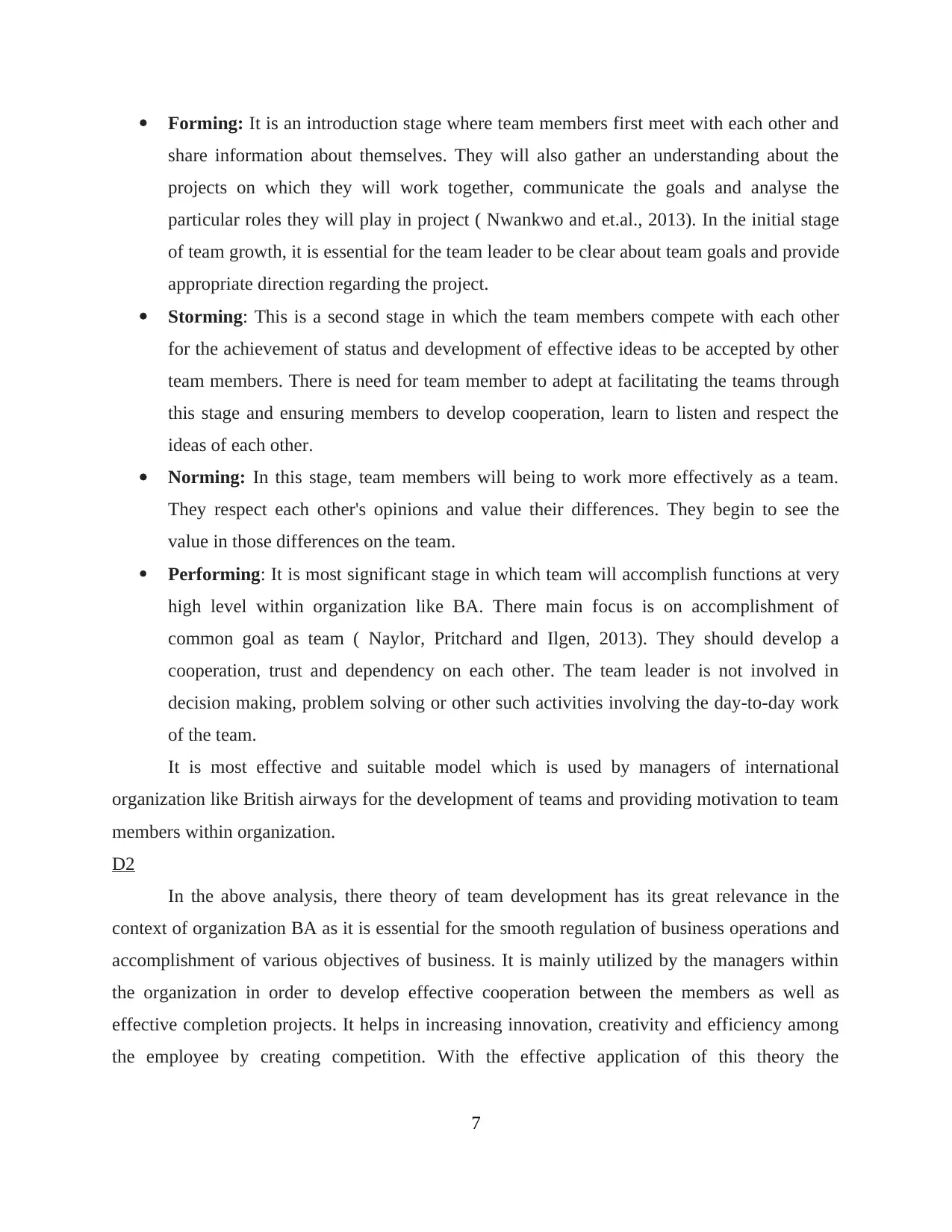
Forming: It is an introduction stage where team members first meet with each other and
share information about themselves. They will also gather an understanding about the
projects on which they will work together, communicate the goals and analyse the
particular roles they will play in project ( Nwankwo and et.al., 2013). In the initial stage
of team growth, it is essential for the team leader to be clear about team goals and provide
appropriate direction regarding the project.
Storming: This is a second stage in which the team members compete with each other
for the achievement of status and development of effective ideas to be accepted by other
team members. There is need for team member to adept at facilitating the teams through
this stage and ensuring members to develop cooperation, learn to listen and respect the
ideas of each other.
Norming: In this stage, team members will being to work more effectively as a team.
They respect each other's opinions and value their differences. They begin to see the
value in those differences on the team.
Performing: It is most significant stage in which team will accomplish functions at very
high level within organization like BA. There main focus is on accomplishment of
common goal as team ( Naylor, Pritchard and Ilgen, 2013). They should develop a
cooperation, trust and dependency on each other. The team leader is not involved in
decision making, problem solving or other such activities involving the day-to-day work
of the team.
It is most effective and suitable model which is used by managers of international
organization like British airways for the development of teams and providing motivation to team
members within organization.
D2
In the above analysis, there theory of team development has its great relevance in the
context of organization BA as it is essential for the smooth regulation of business operations and
accomplishment of various objectives of business. It is mainly utilized by the managers within
the organization in order to develop effective cooperation between the members as well as
effective completion projects. It helps in increasing innovation, creativity and efficiency among
the employee by creating competition. With the effective application of this theory the
7
share information about themselves. They will also gather an understanding about the
projects on which they will work together, communicate the goals and analyse the
particular roles they will play in project ( Nwankwo and et.al., 2013). In the initial stage
of team growth, it is essential for the team leader to be clear about team goals and provide
appropriate direction regarding the project.
Storming: This is a second stage in which the team members compete with each other
for the achievement of status and development of effective ideas to be accepted by other
team members. There is need for team member to adept at facilitating the teams through
this stage and ensuring members to develop cooperation, learn to listen and respect the
ideas of each other.
Norming: In this stage, team members will being to work more effectively as a team.
They respect each other's opinions and value their differences. They begin to see the
value in those differences on the team.
Performing: It is most significant stage in which team will accomplish functions at very
high level within organization like BA. There main focus is on accomplishment of
common goal as team ( Naylor, Pritchard and Ilgen, 2013). They should develop a
cooperation, trust and dependency on each other. The team leader is not involved in
decision making, problem solving or other such activities involving the day-to-day work
of the team.
It is most effective and suitable model which is used by managers of international
organization like British airways for the development of teams and providing motivation to team
members within organization.
D2
In the above analysis, there theory of team development has its great relevance in the
context of organization BA as it is essential for the smooth regulation of business operations and
accomplishment of various objectives of business. It is mainly utilized by the managers within
the organization in order to develop effective cooperation between the members as well as
effective completion projects. It helps in increasing innovation, creativity and efficiency among
the employee by creating competition. With the effective application of this theory the
7
⊘ This is a preview!⊘
Do you want full access?
Subscribe today to unlock all pages.

Trusted by 1+ million students worldwide
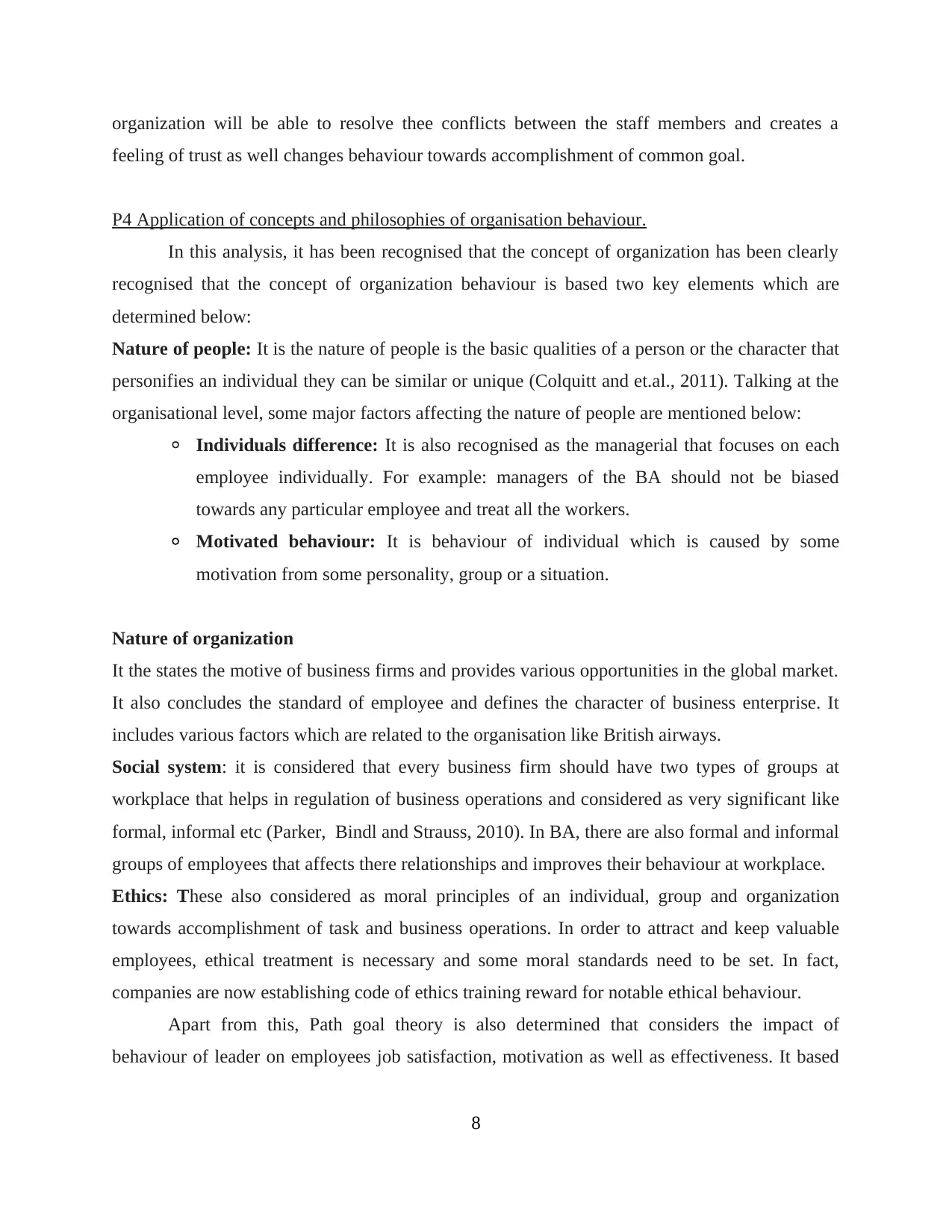
organization will be able to resolve thee conflicts between the staff members and creates a
feeling of trust as well changes behaviour towards accomplishment of common goal.
P4 Application of concepts and philosophies of organisation behaviour.
In this analysis, it has been recognised that the concept of organization has been clearly
recognised that the concept of organization behaviour is based two key elements which are
determined below:
Nature of people: It is the nature of people is the basic qualities of a person or the character that
personifies an individual they can be similar or unique (Colquitt and et.al., 2011). Talking at the
organisational level, some major factors affecting the nature of people are mentioned below:
◦ Individuals difference: It is also recognised as the managerial that focuses on each
employee individually. For example: managers of the BA should not be biased
towards any particular employee and treat all the workers.
◦ Motivated behaviour: It is behaviour of individual which is caused by some
motivation from some personality, group or a situation.
Nature of organization
It the states the motive of business firms and provides various opportunities in the global market.
It also concludes the standard of employee and defines the character of business enterprise. It
includes various factors which are related to the organisation like British airways.
Social system: it is considered that every business firm should have two types of groups at
workplace that helps in regulation of business operations and considered as very significant like
formal, informal etc (Parker, Bindl and Strauss, 2010). In BA, there are also formal and informal
groups of employees that affects there relationships and improves their behaviour at workplace.
Ethics: These also considered as moral principles of an individual, group and organization
towards accomplishment of task and business operations. In order to attract and keep valuable
employees, ethical treatment is necessary and some moral standards need to be set. In fact,
companies are now establishing code of ethics training reward for notable ethical behaviour.
Apart from this, Path goal theory is also determined that considers the impact of
behaviour of leader on employees job satisfaction, motivation as well as effectiveness. It based
8
feeling of trust as well changes behaviour towards accomplishment of common goal.
P4 Application of concepts and philosophies of organisation behaviour.
In this analysis, it has been recognised that the concept of organization has been clearly
recognised that the concept of organization behaviour is based two key elements which are
determined below:
Nature of people: It is the nature of people is the basic qualities of a person or the character that
personifies an individual they can be similar or unique (Colquitt and et.al., 2011). Talking at the
organisational level, some major factors affecting the nature of people are mentioned below:
◦ Individuals difference: It is also recognised as the managerial that focuses on each
employee individually. For example: managers of the BA should not be biased
towards any particular employee and treat all the workers.
◦ Motivated behaviour: It is behaviour of individual which is caused by some
motivation from some personality, group or a situation.
Nature of organization
It the states the motive of business firms and provides various opportunities in the global market.
It also concludes the standard of employee and defines the character of business enterprise. It
includes various factors which are related to the organisation like British airways.
Social system: it is considered that every business firm should have two types of groups at
workplace that helps in regulation of business operations and considered as very significant like
formal, informal etc (Parker, Bindl and Strauss, 2010). In BA, there are also formal and informal
groups of employees that affects there relationships and improves their behaviour at workplace.
Ethics: These also considered as moral principles of an individual, group and organization
towards accomplishment of task and business operations. In order to attract and keep valuable
employees, ethical treatment is necessary and some moral standards need to be set. In fact,
companies are now establishing code of ethics training reward for notable ethical behaviour.
Apart from this, Path goal theory is also determined that considers the impact of
behaviour of leader on employees job satisfaction, motivation as well as effectiveness. It based
8
Paraphrase This Document
Need a fresh take? Get an instant paraphrase of this document with our AI Paraphraser

on four leadership behaviour that aims to maximize workers results by recognizing the impact of
both factors of environment and characteristics of job performance.
Achievement-Oriented Behaviour:This leadership behaviour focuses on promoting
performance by developing goals that challenge workers. Subordinate goals are designed to
encourage high performance, and supervisors exhibit confidence in employees to motivate them
in meeting performance goals. Jobs where the achievement-oriented behaviour of leaders might
predominate are in aviation industry.
Directive path Goal: This behaviour of leadership aims to remove the job functions and
ambiguity (DuBrin, 2013). In this, leaders of BA gives specific expectations to workers related
to performance of organization.
Supportive leader behaviour: in this theory the focus of leaders is to support an individual's
psychological well being. It helps in reduction of stress and frustration in environment of
workplace.
Participative Leader Behaviour: It involves consulting with employee regarding the
preferences in accomplishment of job requirements. Here the subordinates in organization like
BA are directly involved in the decision-making process.
M 4
There is great significance of concept and philosophies of organization as it supports in
development of skills and behaviour of individuals as well as leaders within organization like BA
to manage the team members and provide motivation to accomplish the task and responsibility
which are assigned to the members (Coghlan and Brannick, 2014). These business context, has
been considered significant for the accomplishment of various objectives. Various business
functions have to be performed by the leaders in the path goal theory and act as role model for
the employee to work appropriately. Moreover, nature of organization has defined two different
things such as social system which is essential for employee in accomplishment of various job
responsibilities ta workplace. Other than this, ethics is also considered as important in
organization or individuals that provides a commitment towards accomplishment of organization
goals and develop positive behaviour within individuals groups or team members.
9
both factors of environment and characteristics of job performance.
Achievement-Oriented Behaviour:This leadership behaviour focuses on promoting
performance by developing goals that challenge workers. Subordinate goals are designed to
encourage high performance, and supervisors exhibit confidence in employees to motivate them
in meeting performance goals. Jobs where the achievement-oriented behaviour of leaders might
predominate are in aviation industry.
Directive path Goal: This behaviour of leadership aims to remove the job functions and
ambiguity (DuBrin, 2013). In this, leaders of BA gives specific expectations to workers related
to performance of organization.
Supportive leader behaviour: in this theory the focus of leaders is to support an individual's
psychological well being. It helps in reduction of stress and frustration in environment of
workplace.
Participative Leader Behaviour: It involves consulting with employee regarding the
preferences in accomplishment of job requirements. Here the subordinates in organization like
BA are directly involved in the decision-making process.
M 4
There is great significance of concept and philosophies of organization as it supports in
development of skills and behaviour of individuals as well as leaders within organization like BA
to manage the team members and provide motivation to accomplish the task and responsibility
which are assigned to the members (Coghlan and Brannick, 2014). These business context, has
been considered significant for the accomplishment of various objectives. Various business
functions have to be performed by the leaders in the path goal theory and act as role model for
the employee to work appropriately. Moreover, nature of organization has defined two different
things such as social system which is essential for employee in accomplishment of various job
responsibilities ta workplace. Other than this, ethics is also considered as important in
organization or individuals that provides a commitment towards accomplishment of organization
goals and develop positive behaviour within individuals groups or team members.
9
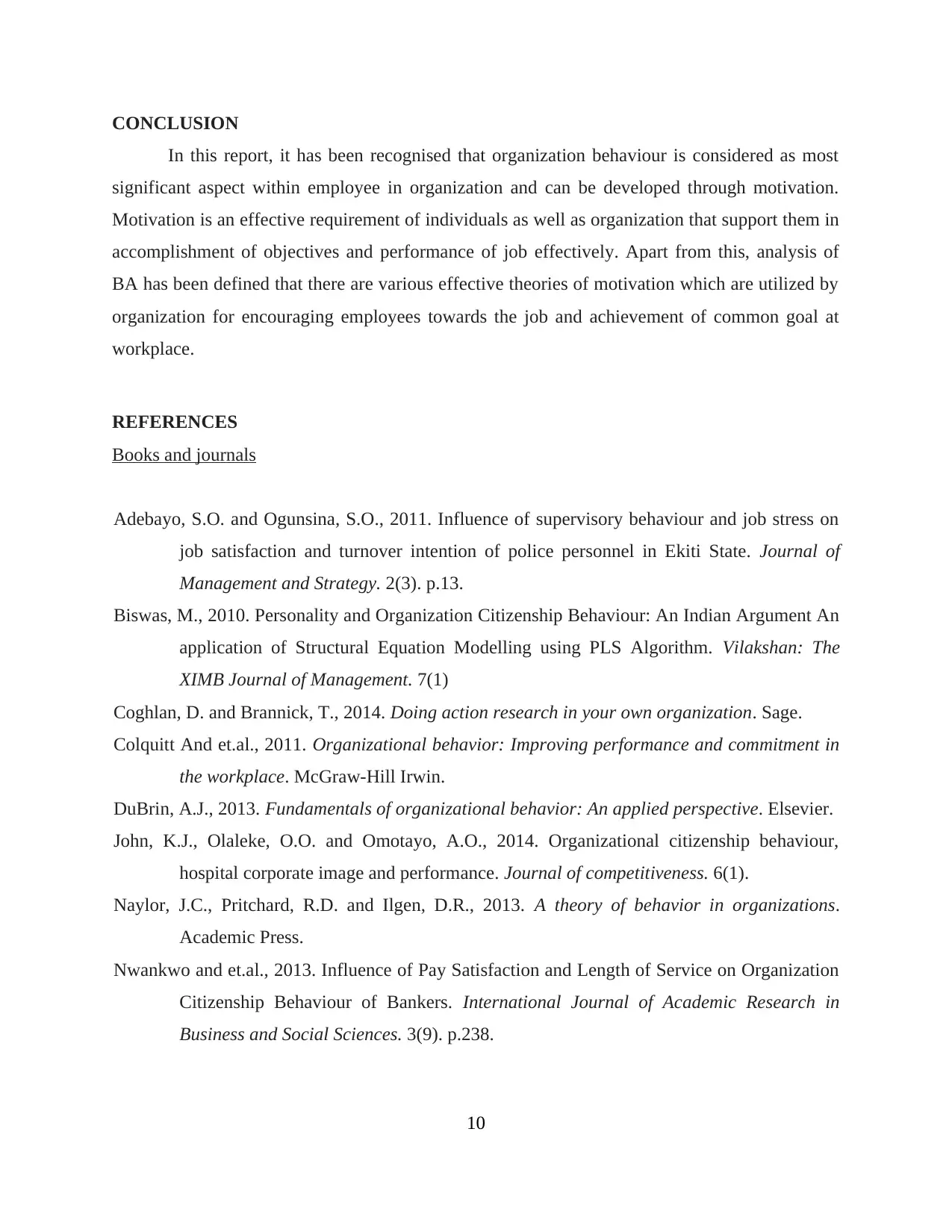
CONCLUSION
In this report, it has been recognised that organization behaviour is considered as most
significant aspect within employee in organization and can be developed through motivation.
Motivation is an effective requirement of individuals as well as organization that support them in
accomplishment of objectives and performance of job effectively. Apart from this, analysis of
BA has been defined that there are various effective theories of motivation which are utilized by
organization for encouraging employees towards the job and achievement of common goal at
workplace.
REFERENCES
Books and journals
Adebayo, S.O. and Ogunsina, S.O., 2011. Influence of supervisory behaviour and job stress on
job satisfaction and turnover intention of police personnel in Ekiti State. Journal of
Management and Strategy. 2(3). p.13.
Biswas, M., 2010. Personality and Organization Citizenship Behaviour: An Indian Argument An
application of Structural Equation Modelling using PLS Algorithm. Vilakshan: The
XIMB Journal of Management. 7(1)
Coghlan, D. and Brannick, T., 2014. Doing action research in your own organization. Sage.
Colquitt And et.al., 2011. Organizational behavior: Improving performance and commitment in
the workplace. McGraw-Hill Irwin.
DuBrin, A.J., 2013. Fundamentals of organizational behavior: An applied perspective. Elsevier.
John, K.J., Olaleke, O.O. and Omotayo, A.O., 2014. Organizational citizenship behaviour,
hospital corporate image and performance. Journal of competitiveness. 6(1).
Naylor, J.C., Pritchard, R.D. and Ilgen, D.R., 2013. A theory of behavior in organizations.
Academic Press.
Nwankwo and et.al., 2013. Influence of Pay Satisfaction and Length of Service on Organization
Citizenship Behaviour of Bankers. International Journal of Academic Research in
Business and Social Sciences. 3(9). p.238.
10
In this report, it has been recognised that organization behaviour is considered as most
significant aspect within employee in organization and can be developed through motivation.
Motivation is an effective requirement of individuals as well as organization that support them in
accomplishment of objectives and performance of job effectively. Apart from this, analysis of
BA has been defined that there are various effective theories of motivation which are utilized by
organization for encouraging employees towards the job and achievement of common goal at
workplace.
REFERENCES
Books and journals
Adebayo, S.O. and Ogunsina, S.O., 2011. Influence of supervisory behaviour and job stress on
job satisfaction and turnover intention of police personnel in Ekiti State. Journal of
Management and Strategy. 2(3). p.13.
Biswas, M., 2010. Personality and Organization Citizenship Behaviour: An Indian Argument An
application of Structural Equation Modelling using PLS Algorithm. Vilakshan: The
XIMB Journal of Management. 7(1)
Coghlan, D. and Brannick, T., 2014. Doing action research in your own organization. Sage.
Colquitt And et.al., 2011. Organizational behavior: Improving performance and commitment in
the workplace. McGraw-Hill Irwin.
DuBrin, A.J., 2013. Fundamentals of organizational behavior: An applied perspective. Elsevier.
John, K.J., Olaleke, O.O. and Omotayo, A.O., 2014. Organizational citizenship behaviour,
hospital corporate image and performance. Journal of competitiveness. 6(1).
Naylor, J.C., Pritchard, R.D. and Ilgen, D.R., 2013. A theory of behavior in organizations.
Academic Press.
Nwankwo and et.al., 2013. Influence of Pay Satisfaction and Length of Service on Organization
Citizenship Behaviour of Bankers. International Journal of Academic Research in
Business and Social Sciences. 3(9). p.238.
10
⊘ This is a preview!⊘
Do you want full access?
Subscribe today to unlock all pages.

Trusted by 1+ million students worldwide
1 out of 13
Related Documents
Your All-in-One AI-Powered Toolkit for Academic Success.
+13062052269
info@desklib.com
Available 24*7 on WhatsApp / Email
![[object Object]](/_next/static/media/star-bottom.7253800d.svg)
Unlock your academic potential
Copyright © 2020–2025 A2Z Services. All Rights Reserved. Developed and managed by ZUCOL.




